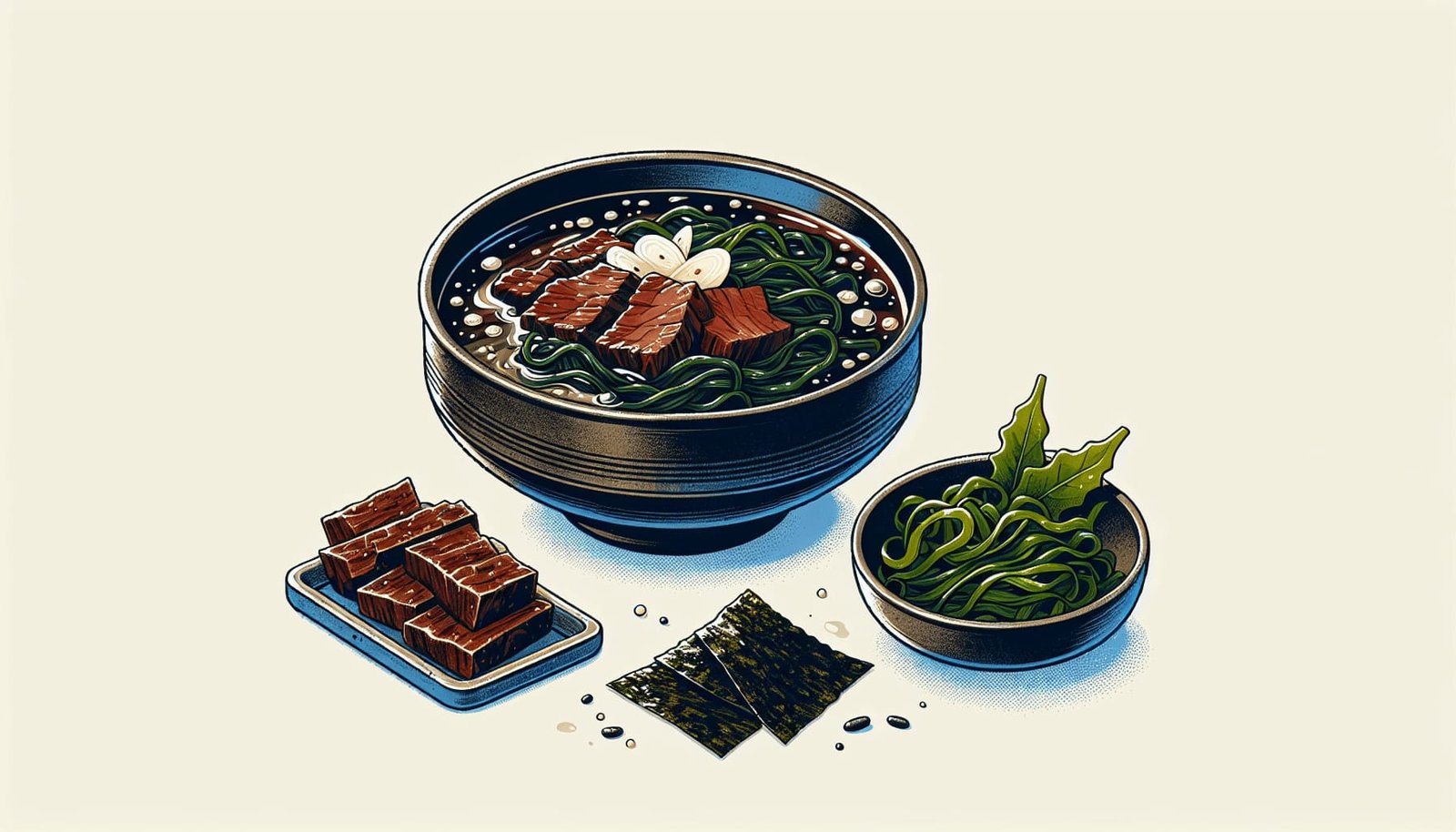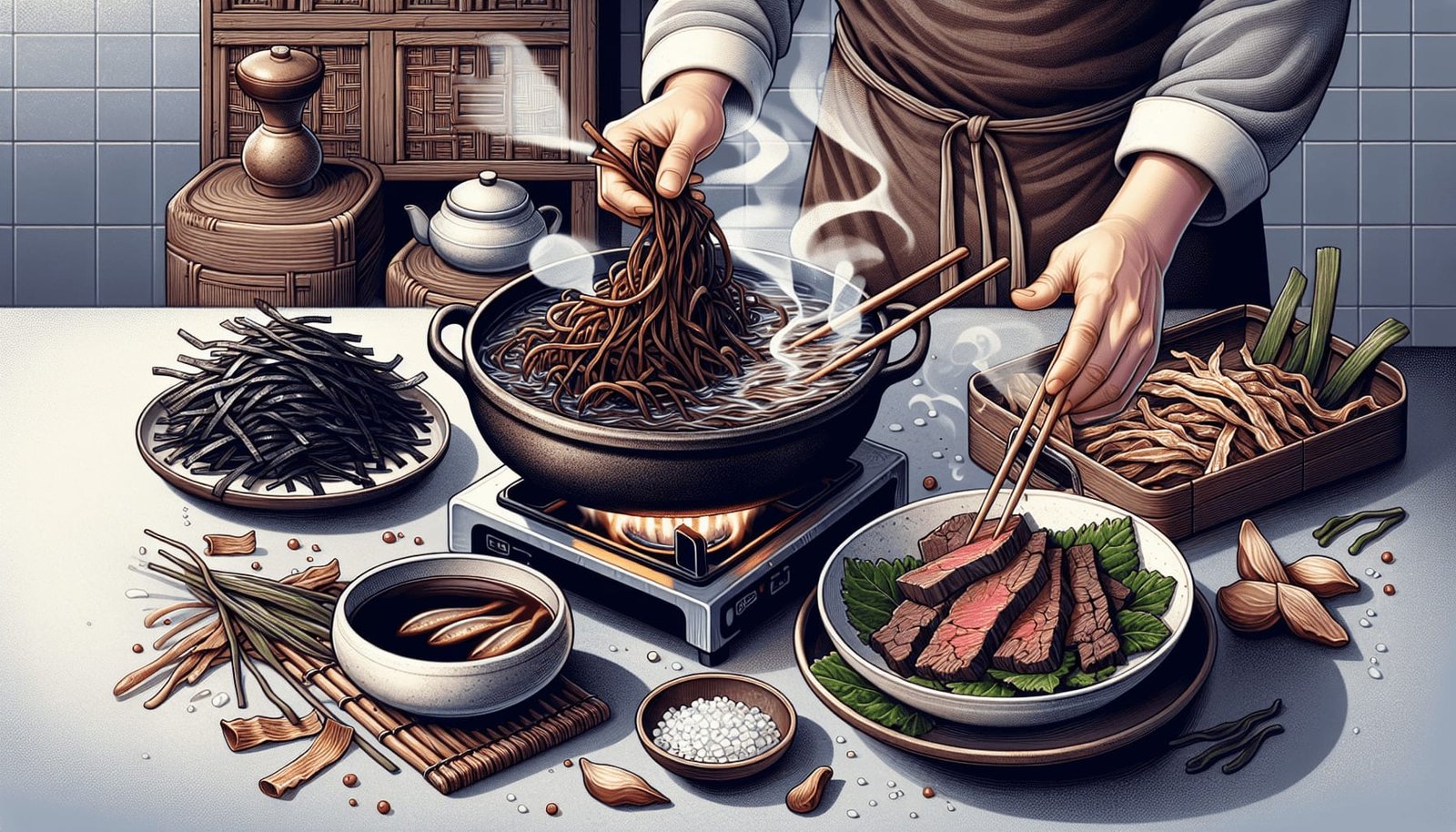Have you ever wondered about the secrets behind the delicious and nutritious traditional Korean seaweed soup, known as miyeokguk? This article will take you on a culinary journey as it unravels the preparation and serving methods of this beloved Korean dish. From the careful selection of dried seaweed to the hearty broth filled with flavors, you will discover the intricate steps involved in creating this comforting and wholesome soup. So sit back, relax, and get ready to tantalize your taste buds with the irresistible miyeokguk.

Ingredients
Seaweed (miyeok)
When preparing traditional Korean seaweed soup, the key ingredient is miyeok, which is dried seaweed. Miyeok is known for its nutritional value, being rich in vitamins and minerals. It provides a unique flavor and texture to the soup, making it incredibly savory and satisfying.
Beef or Seafood
Another essential ingredient for miyeokguk is the choice between beef or seafood. Some people prefer using beef, such as beef brisket or beef flank, to add a meaty element to the soup. Others prefer using seafood, like clams or mussels, for a lighter and more delicate taste. Both options are delicious, so it’s a matter of personal preference.
Vegetables
To enhance the flavor and nutritional value of the soup, various vegetables are added. Common vegetables used in miyeokguk include onions, green onions, radishes, and shiitake mushrooms. These vegetables provide additional texture and create a balanced and delightful combination of flavors.
Sesame Oil
Sesame oil is a beloved ingredient in Korean cuisine, and it plays a crucial role in miyeokguk. Adding just a drizzle of sesame oil to the soup enhances the overall taste and adds a rich, nutty aroma. It brings a unique depth to the dish, making it even more irresistible.
Soy Sauce
Soy sauce is a staple in Korean cooking, and it adds a savory and umami flavor to miyeokguk. It helps bring out the natural flavors of the beef or seafood, while also providing a pleasant saltiness to the soup. Just a splash of soy sauce can make a significant difference in the final result.
Salt
To ensure the perfect balance of flavors, a pinch of salt is added to the soup. It helps enhance the taste of the ingredients and brings out their natural flavors. It is important to use salt sparingly and adjust according to personal preference.
Garlic
Garlic is a flavor powerhouse in Korean cuisine, and miyeokguk is no exception. Adding fresh garlic cloves or garlic powder to the soup adds a distinct and aromatic taste. It brings depth and complexity to the flavor profile, making the soup more enticing.
Soup Stock
To create the base of miyeokguk, a flavorful soup stock is essential. The stock can be made from various ingredients such as beef bones, anchovies, or kelp. These ingredients are simmered to extract their flavors, creating a rich and fragrant broth that serves as the foundation for the soup.
Preparation
Soaking the Seaweed
Before using the dried seaweed (miyeok), it needs to be soaked in water. The soaking process helps rehydrate the seaweed, making it more pliable and ready for cooking. To soak the seaweed, rinse it thoroughly under cold water to remove any impurities, and then place it in a bowl filled with water. Allow the seaweed to soak for about 30 minutes or until it becomes soft and slightly expanded.
Preparing the Beef or Seafood
If using beef, slice it into thin pieces and marinate it with a little soy sauce, garlic, and black pepper. This marinating step adds an extra layer of flavor to the beef, making it more tender and tasty. On the other hand, if using seafood, ensure that it is cleaned properly and ready for cooking. Remove any shells or unwanted parts, and set it aside until needed.
Chopping the Vegetables
Next, it’s time to chop the vegetables. Peel and dice an onion, slice the green onions into small pieces, peel and slice the radishes, and soak the dried shiitake mushrooms until they become soft. Once the vegetables are prepared, they are ready to be cooked and added to the soup later on.
Making the Soup Stock
To create a flavorful soup stock, it’s important to use high-quality ingredients. If using beef bones, simmer them in water with some onion and garlic for several hours until the broth becomes rich and savory. If using anchovies or kelp, boil them in water for around 30 minutes to extract their flavors. Once the stock is ready, strain it to remove any solids and set it aside for later use.

Cooking Process
Boiling the Seaweed
After soaking the seaweed, drain the water and rinse it once again under cold water. Place the seaweed in a pot along with the prepared soup stock and let it simmer for about 20 minutes. The seaweed will continue to soften and release its flavors into the soup, creating a delightful aroma.
Adding the Beef or Seafood
Once the seaweed has cooked for about 20 minutes, it’s time to add the beef or seafood to the pot. Gently place the marinated beef slices or the cleaned seafood into the simmering soup. Allow the meat or seafood to cook thoroughly, which usually takes around 5-10 minutes, ensuring that it is cooked to perfection.
Cooking the Vegetables
Now it’s time to add the chopped vegetables to the soup. Place the diced onion, sliced green onions, sliced radishes, and soaked shiitake mushrooms into the pot. Allow the vegetables to cook in the simmering soup for approximately 10-15 minutes or until they become tender and blend harmoniously with the other ingredients.
Seasoning the Soup
To elevate the flavors, it’s important to season the soup with salt and soy sauce. Start by adding a pinch of salt and soy sauce, and then adjust according to personal preference. Stir the soup gently to ensure the seasoning is evenly distributed and taste along the way to achieve the desired level of saltiness and depth of flavor.

Presentation
Serving in Individual Bowls
Once the miyeokguk is cooked to perfection, it’s time to present it in individual bowls. Ladle a generous amount of the soup into each bowl, ensuring that every serving contains a harmonious mix of seaweed, beef or seafood, and vegetables. The individual bowls not only create an appetizing presentation but also allow each person to enjoy their own portion of this comforting and nutritious soup.
Garnishing with Sesame Oil
To add a final touch of flavor and aroma, garnish each bowl of miyeokguk with a drizzle of sesame oil. The sesame oil enhances the overall taste of the soup and gives it a beautiful sheen. Its nutty flavor adds an extra layer of complexity, making each spoonful of the soup even more enjoyable.
Accompanying with Rice and Kimchi
Miyeokguk is traditionally served with steamed rice and kimchi. The combination of the warm, comforting soup with the fluffy rice and flavorful kimchi creates a well-rounded and satisfying meal. The tangy and spicy kimchi complements the savory and umami flavors of the soup, making each bite a delightful experience.
In conclusion, traditional Korean seaweed soup (miyeokguk) is prepared by soaking the seaweed, preparing the beef or seafood, chopping the vegetables, making the soup stock, boiling the seaweed, adding the beef or seafood, cooking the vegetables, and seasoning the soup. The soup is then presented in individual bowls, garnished with sesame oil, and served with rice and kimchi. With its rich flavors and nutritional benefits, miyeokguk is not only a staple in Korean cuisine but also a comforting and delicious dish that is enjoyed by many.

